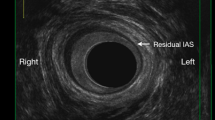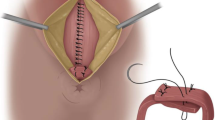Abstract
Background
Troublesome fecal incontinence following a lateral internal sphincterotomy is often attributed to faulty surgical technique. However, it may be associated with coexisting occult sphincter defects. Whether continence is related to the extent of sphincterotomy remains debatable. The aim of the study is to identify fecal incontinence related to chronic anal fissure before and after lateral internal sphincterotomy and its relationship to the extent of internal anal sphincter division.
Methods
One hundred eight patients with chronic anal fissure were prospectively studied before and after lateral internal sphincterotomy. A questionnaire was completed for each patient before and after surgery with regard to any degree of fecal incontinence. Fecal incontinence severity index was assessed using the Cleveland Clinic Incontinence Score. The patients with preoperative perfect continence were randomized into two groups (46 patients in each group): Group 1 underwent traditional lateral internal sphincterotomy (up to the dentate line) and Group 2 were underwent a conservative internal anal sphincterotomy (up to the height of the fissure apex or just below it).
Results
Minor degrees of incontinence were present before surgery in 16 patients (14.8%). Results of the randomized trial revealed that temporary postoperative incontinence was newly developed in 6/92 of patients (6.52 %) who did not have it before surgery. Five of the six (10.86%) were in Group 1 one (2.17%) was in Group 2 (p = 0.039). Persistent incontinence occurred in two in Group 1 (4.35%). All of them were females. All have had a history of one or more vaginal deliveries.
Conclusion
A mild degree of fecal incontinence may be associated with chronic anal fissure at presentation rather than as a result of internal sphincterotomy. Troublesome fecal incontinence after lateral internal sphincterotomy is uncommon. Sphincterotomy up to the dentate line provided faster pain relief and faster anal fissure healing, but it was associated with a significant postoperative alteration in fecal incontinence than was sphincterotomy up to the fissure apex. Care should be exercised in female patients with a history of previous obstetric trauma, as internal anal sphincter division may further compromise sphincter function.
Similar content being viewed by others
References
Zhar AP, Beer-Gabel M, Chiappa AC, et al. (2001) Fecal incontinence after minor anorectal surgery. Dis Colon Rectum 44(11):1610–1619
Ammari FF, Bani-Hani KE (2004) Fecal incontinence in patients with anal fissure: A consequence of internal sphincterotomy or a feature of the condition? Surgeon 2(4):225–229
Tjandra JJ, Han WR, Ooi BS, et al. (2001) Fecal incontinence after lateral internal sphincterotomy is often associated with coexisting occult sphincter defects: a study using endoanal ultrasonography. ANZ J Surg 71(10):598–602
Pernikoff BJ, Eisenstat TE, Rubin RJ, et al. (1994) Reappraisal of partial lateral internal sphincterotomy. Dis Colon Rectum 37(12):1291–1295
Church JM, Fleshman JW, Kane RL, et al. (1999) Patient and surgeon ranking of the severity of symptoms associated with fecal incontinence: the fecal incontinence severity index. Dis Colon Rectum 42(12):1525–1532
Penninckx F, Lestar B, Kerremans R (1992) The internal anal sphincter: mechanisms of control and its role in maintaining anal continence. Baillieres Clin Gastroenterol 6:193–214
Johanson JF, Lafferty J (1996) Epidemiology of fecal incontinence: the silent affliction. Am J Gastroenterol 91:33–36
Khubchandani IT, Reed JF (1989) Sequelae of internal sphincterotomy for chronic fissure in ano. Br J Surg 76:431–434
Nyam DC, Pemberton JH (1999) Long-term results of lateral internal sphincterotomy for chronic anal fissure with particular reference to incidence of fecal incontinence. Dis Colon Rectum 42:1306–1310
Nelson RL (2002) Outcome of operative procedures for fissure in ano. Cochrane Database Syst Rev (1):CD002199
Landsend E, Johnson E, Johannessen HO, et al. (2003) Surgical treatment of anal fissure. Tidsskr Nor Laegeforen 123(23):3366–3367
Garcea G, Sutton C, Mansoori S, et al. (2003) Results following conservative lateral sphincteromy for the treatment of chronic anal fissures. Colorectal Dis 5(4):311–314
Lindsey I, Jones OM, Smilgin-Humphreys MM, et al. (2004) Patterns of fecal incontinence after anal surgery. Dis Colon Rectum 47(10):1643–1649
Tocchi A, Mazzoni G, Miccini M, et al. (2004) Total lateral sphincterotomy for anal fissure. Int J Colorectal Dis 19(3):245–249
Cho DY (2005) Controlled lateral sphincterotomy for chronic anal fissure. Dis Colon Rectum 48(5):1037–1041
Rosa G, Lolli P, Piccinelli D, et al. (2005) Calibrated lateral internal sphincterotomy for chronic anal fissure. Tech Coloproctol 9(2):127–131
Prohm P, Bonner C (1995) Is manometry essential for surgery of chronic fissure-in-ano? Dis Colon Rectum 38(7):735–738
Garcia-Aguilar J, Belmonte C, Wong D, et al. (1996) Open vs closed sphincterotomy for chronic anal fissure: long term results. Dis Colon Rectum 39:440–443
Arroyo A, Perez F, Serrano P, et al. (2004) Open versus closed lateral sphincterotomy performed as an outpatient procedure under local anesthesia for chronic anal fissure: prospective randomized study of clinical and manometric long-term results. J Am Coll Surg 199(3):361–367
Wiley M, Day P, Rieger N, et al. (2004) Open vs. closed lateral internal sphincterotomy for idiopathic fissure-in-ano: a prospective, randomized, controlled trial. Dis Colon Rectum 47(6):847–852
Felt-Bersma RJ, van Baren R, Koorevaar M, et al. (1995) Unsuspected sphincter defects shown by anal endosonography after anorectal surgery. A prospective study. Dis Colon Rectum 38(3):249–253
Ram E, Alper D, Stein GY, et al. (2005) Internal anal sphincter function following lateral internal sphincterotomy for anal fissure: a long-term manometric study. Ann Surg 242(2):208–211
Rotholtz NA, Bun M, Mauri MV, et al. (2005) Long-term assessment of fecal incontinence after lateral internal sphincterotomy. Tech Coloproctol 9(2):115–118
Casillas S, Hull TL, Zutshi M, et al. (2005) Incontinence after a lateral internal sphincterotomy: are we underestimating it? Dis Colon Rectum 48(6):1193–1199
Damon H, Bretones S, Henry L, et al. (2005) Long-term consequences of first vaginal delivery-induced anal sphincter defect. Dis Colon Rectum 48(9):1772–1776
Author information
Authors and Affiliations
Corresponding author
Rights and permissions
About this article
Cite this article
Elsebae, M.M.A. A Study of Fecal Incontinence in Patients with Chronic Anal Fissure: Prospective, Randomized, Controlled Trial of the Extent of Internal Anal Sphincter Division During Lateral Sphincterotomy. World J Surg 31, 2052–2057 (2007). https://doi.org/10.1007/s00268-007-9177-1
Published:
Issue Date:
DOI: https://doi.org/10.1007/s00268-007-9177-1




